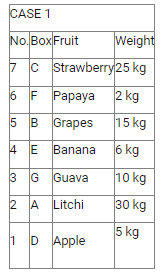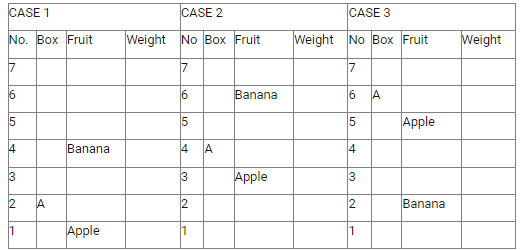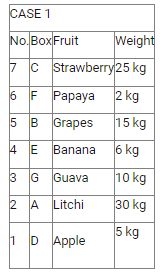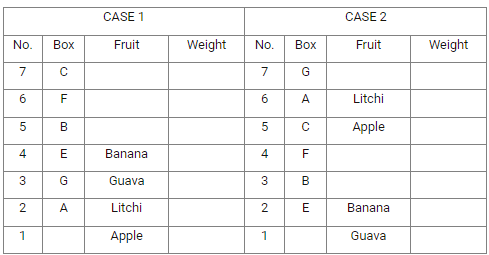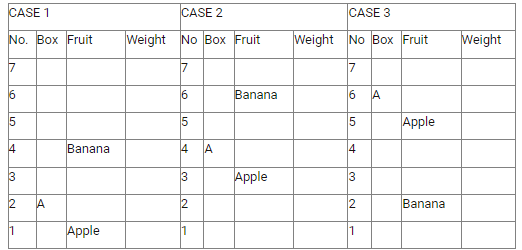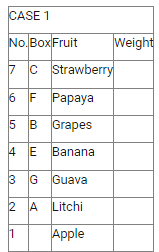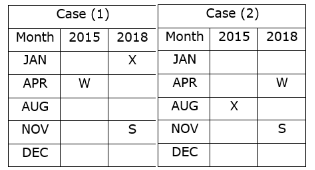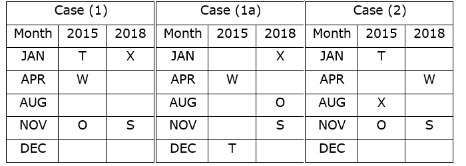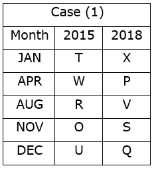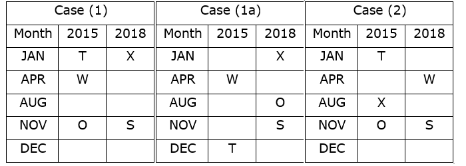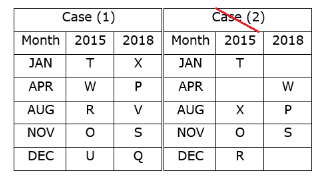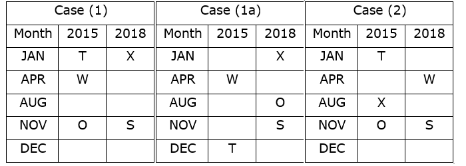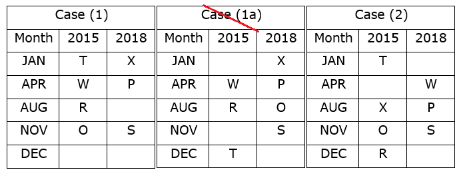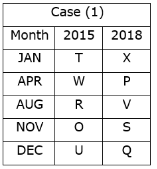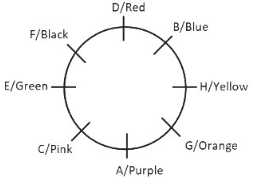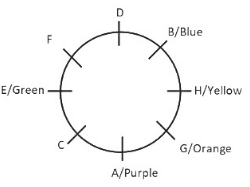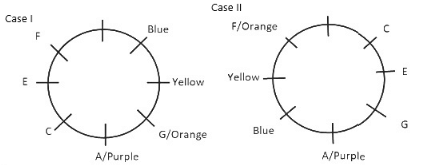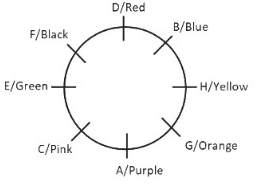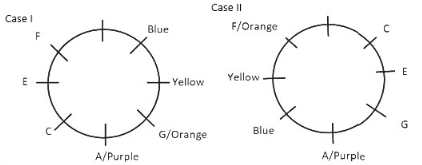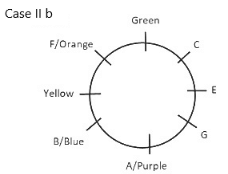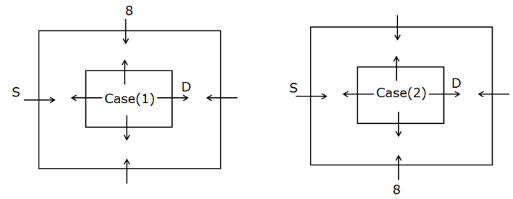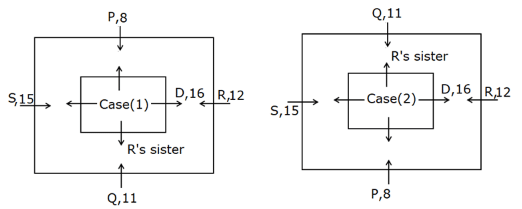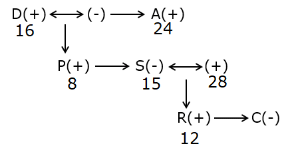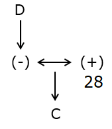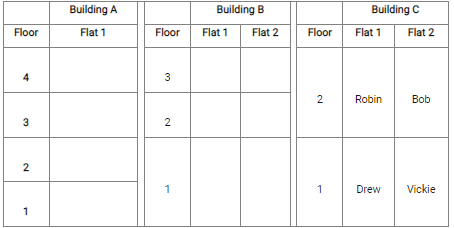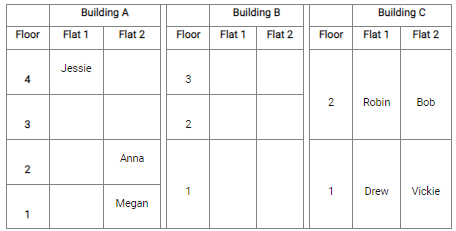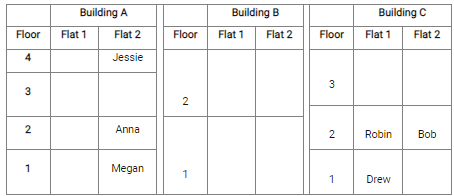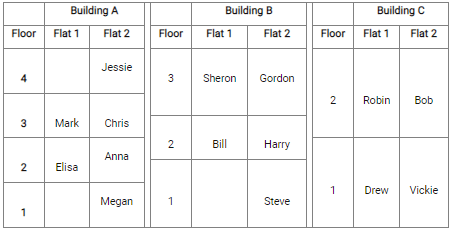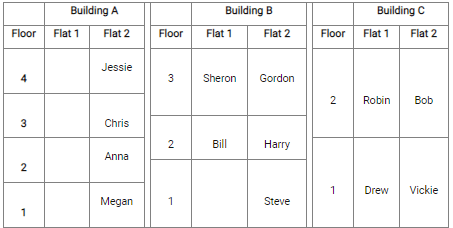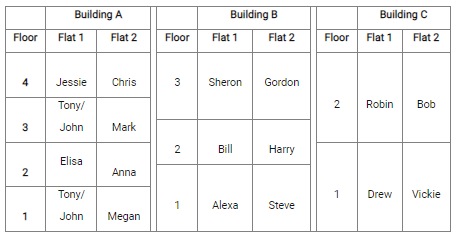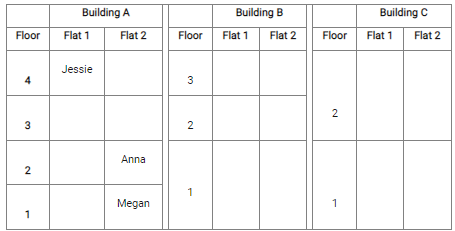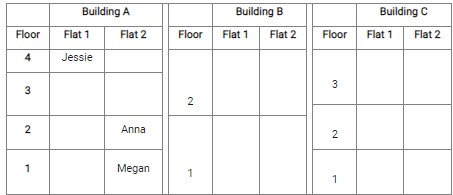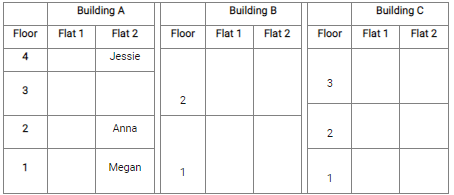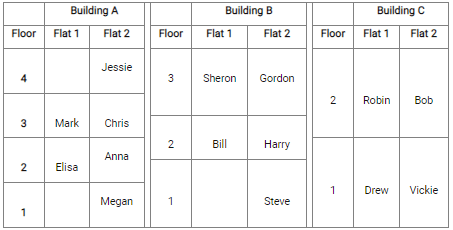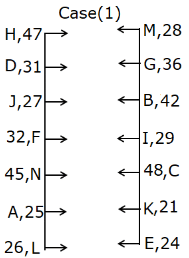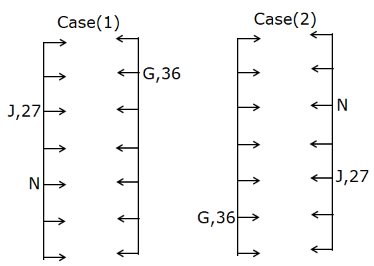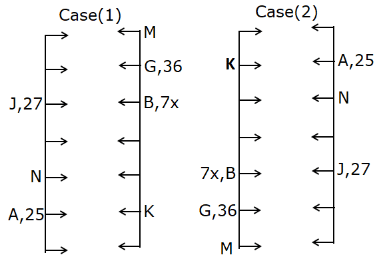IBPS PO Mains Mock Test - 9 - Bank Exams MCQ
30 Questions MCQ Test - IBPS PO Mains Mock Test - 9
Direction: Study the following information carefully and answer the question:
Seven different boxes A, B, C, D, E, F and G contain seven different fruits namely viz. Banana, Guava, Grapes, Apple, Papaya, Litchi and Strawberry are arranged one above the other. The box at the bottom of arrangement is numbered 1, the above box is numbered 2 and so on. Each box has a different weight. Second heaviest box is kept at the top while the second lightest box is kept at the bottom. The box which contains Apple is immediately below A. Only one box is placed between the Banana box and F. G is immediately above the Litchi box. More than two boxes are above the box that contains Banana. Box C is five times heavier than box D. Only two boxes are between the Guava box and the box that contains Papaya. Only two boxes are between the box which contains Apple and the box which contains Banana. B is immediately above E. The heaviest box is three times heavier than the box which is kept just above it and two times heavier than the Box B. The box filled which Grapes is neither at the top nor at the bottom of the arrangement. Box B does not contain Banana. Only one box is between box B and the box which is filled with Guava. Box E is three times heavier than the box which is second from the top. B is placed above the Guava box. C is placed immediately above F which is 3 kg lighter than the box which contains Apple. Neither C nor G contains Apple. Box A is kept at an even numbered position below the box which contains Banana. Box which contains Papaya weighs 2 kg. The weight of box which contains Litchi is equal to the sum of the weights of boxes which contain Apple and Strawberry.
Which of the following combination is true?
Direction: Study the following information carefully and answer the question:
Seven different boxes A, B, C, D, E, F and G contain seven different fruits namely viz. Banana, Guava, Grapes, Apple, Papaya, Litchi and Strawberry are arranged one above the other. The box at the bottom of arrangement is numbered 1, the above box is numbered 2 and so on. Each box has a different weight. Second heaviest box is kept at the top while the second lightest box is kept at the bottom. The box which contains Apple is immediately below A. Only one box is placed between the Banana box and F. G is immediately above the Litchi box. More than two boxes are above the box that contains Banana. Box C is five times heavier than box D. Only two boxes are between the Guava box and the box that contains Papaya. Only two boxes are between the box which contains Apple and the box which contains Banana. B is immediately above E. The heaviest box is three times heavier than the box which is kept just above it and two times heavier than the Box B. The box filled which Grapes is neither at the top nor at the bottom of the arrangement. Box B does not contain Banana. Only one box is between box B and the box which is filled with Guava. Box E is three times heavier than the box which is second from the top. B is placed above the Guava box. C is placed immediately above F which is 3 kg lighter than the box which contains Apple. Neither C nor G contains Apple. Box A is kept at an even numbered position below the box which contains Banana. Box which contains Papaya weighs 2 kg. The weight of box which contains Litchi is equal to the sum of the weights of boxes which contain Apple and Strawberry.
Which among the following is exactly between (F) and (A)?
Direction: Study the following information carefully and answer the question:
Seven different boxes A, B, C, D, E, F and G contain seven different fruits namely viz. Banana, Guava, Grapes, Apple, Papaya, Litchi and Strawberry are arranged one above the other. The box at the bottom of arrangement is numbered 1, the above box is numbered 2 and so on. Each box has a different weight. Second heaviest box is kept at the top while the second lightest box is kept at the bottom. The box which contains Apple is immediately below A. Only one box is placed between the Banana box and F. G is immediately above the Litchi box. More than two boxes are above the box that contains Banana. Box C is five times heavier than box D. Only two boxes are between the Guava box and the box that contains Papaya. Only two boxes are between the box which contains Apple and the box which contains Banana. B is immediately above E. The heaviest box is three times heavier than the box which is kept just above it and two times heavier than the Box B. The box filled which Grapes is neither at the top nor at the bottom of the arrangement. Box B does not contain Banana. Only one box is between box B and the box which is filled with Guava. Box E is three times heavier than the box which is second from the top. B is placed above the Guava box. C is placed immediately above F which is 3 kg lighter than the box which contains Apple. Neither C nor G contains Apple. Box A is kept at an even numbered position below the box which contains Banana. Box which contains Papaya weighs 2 kg. The weight of box which contains Litchi is equal to the sum of the weights of boxes which contain Apple and Strawberry.
Which of the following pairs occupies the top and bottom positions of the arrangement?
Direction: Study the following information carefully and answer the question:
Seven different boxes A, B, C, D, E, F and G contain seven different fruits namely viz. Banana, Guava, Grapes, Apple, Papaya, Litchi and Strawberry are arranged one above the other. The box at the bottom of arrangement is numbered 1, the above box is numbered 2 and so on. Each box has a different weight. Second heaviest box is kept at the top while the second lightest box is kept at the bottom. The box which contains Apple is immediately below A. Only one box is placed between the Banana box and F. G is immediately above the Litchi box. More than two boxes are above the box that contains Banana. Box C is five times heavier than box D. Only two boxes are between the Guava box and the box that contains Papaya. Only two boxes are between the box which contains Apple and the box which contains Banana. B is immediately above E. The heaviest box is three times heavier than the box which is kept just above it and two times heavier than the Box B. The box filled which Grapes is neither at the top nor at the bottom of the arrangement. Box B does not contain Banana. Only one box is between box B and the box which is filled with Guava. Box E is three times heavier than the box which is second from the top. B is placed above the Guava box. C is placed immediately above F which is 3 kg lighter than the box which contains Apple. Neither C nor G contains Apple. Box A is kept at an even numbered position below the box which contains Banana. Box which contains Papaya weighs 2 kg. The weight of box which contains Litchi is equal to the sum of the weights of boxes which contain Apple and Strawberry.
What is the sum of the weights of the box which is at 1st, 3rd and 6th position?
Direction: Study the following information carefully and answer the question:
Seven different boxes A, B, C, D, E, F and G contain seven different fruits namely viz. Banana, Guava, Grapes, Apple, Papaya, Litchi and Strawberry are arranged one above the other. The box at the bottom of arrangement is numbered 1, the above box is numbered 2 and so on. Each box has a different weight. Second heaviest box is kept at the top while the second lightest box is kept at the bottom. The box which contains Apple is immediately below A. Only one box is placed between the Banana box and F. G is immediately above the Litchi box. More than two boxes are above the box that contains Banana. Box C is five times heavier than box D. Only two boxes are between the Guava box and the box that contains Papaya. Only two boxes are between the box which contains Apple and the box which contains Banana. B is immediately above E. The heaviest box is three times heavier than the box which is kept just above it and two times heavier than the Box B. The box filled which Grapes is neither at the top nor at the bottom of the arrangement. Box B does not contain Banana. Only one box is between box B and the box which is filled with Guava. Box E is three times heavier than the box which is second from the top. B is placed above the Guava box. C is placed immediately above F which is 3 kg lighter than the box which contains Apple. Neither C nor G contains Apple. Box A is kept at an even numbered position below the box which contains Banana. Box which contains Papaya weighs 2 kg. The weight of box which contains Litchi is equal to the sum of the weights of boxes which contain Apple and Strawberry.
What is the weight of the box which contains Litchi?
Study the following information carefully and answer the below questions.
Ten persons –O, P, Q, R, S, T, U, V, W, and X were born in five different months viz.- January, April, August, November, and December in two different years viz.- 2015 and 2018. All the information is not necessary in the same order. Only one person was born in each given month of the same year.
S was born in November 2018. Three persons were born between W and X whereas both of them were born in different years. Neither W nor X was born adjacent to S. X was born in a month which has an odd number of days. O was born three persons after T, who was not born in the same month as W and S. Neither X nor R was born in the same month as O. The number of persons born between X and R is one less than the number of persons born after P. R was born in 2015 and was not born in the month which has an even number of days. Two persons were born between U and V. Neither U nor Q was born in the same month as R.
How many persons were born between T and the one who was born in the same month as V?
Study the following information carefully and answer the below questions.
Ten persons –O, P, Q, R, S, T, U, V, W, and X were born in five different months viz.- January, April, August, November, and December in two different years viz.- 2015 and 2018. All the information is not necessary in the same order. Only one person was born in each given month of the same year.
S was born in November 2018. Three persons were born between W and X whereas both of them were born in different years. Neither W nor X was born adjacent to S. X was born in a month which has an odd number of days. O was born three persons after T, who was not born in the same month as W and S. Neither X nor R was born in the same month as O. The number of persons born between X and R is one less than the number of persons born after P. R was born in 2015 and was not born in the month which has an even number of days. Two persons were born between U and V. Neither U nor Q was born in the same month as R.
Four of the following five are related to each other in a certain way and thus form a group, find the one which does not belong to that group.
Study the following information carefully and answer the below questions.
Ten persons –O, P, Q, R, S, T, U, V, W, and X were born in five different months viz.- January, April, August, November, and December in two different years viz.- 2015 and 2018. All the information is not necessary in the same order. Only one person was born in each given month of the same year.
S was born in November 2018. Three persons were born between W and X whereas both of them were born in different years. Neither W nor X was born adjacent to S. X was born in a month which has an odd number of days. O was born three persons after T, who was not born in the same month as W and S. Neither X nor R was born in the same month as O. The number of persons born between X and R is one less than the number of persons born after P. R was born in 2015 and was not born in the month which has an even number of days. Two persons were born between U and V. Neither U nor Q was born in the same month as R.
Who among the following person was born in the month which has an odd number of days?
I. The one who was born just before U
II. R
III. The one who was born three persons after X
Study the following information carefully and answer the below questions.
Ten persons –O, P, Q, R, S, T, U, V, W, and X were born in five different months viz.- January, April, August, November, and December in two different years viz.- 2015 and 2018. All the information is not necessary in the same order. Only one person was born in each given month of the same year.
S was born in November 2018. Three persons were born between W and X whereas both of them were born in different years. Neither W nor X was born adjacent to S. X was born in a month which has an odd number of days. O was born three persons after T, who was not born in the same month as W and S. Neither X nor R was born in the same month as O. The number of persons born between X and R is one less than the number of persons born after P. R was born in 2015 and was not born in the month which has an even number of days. Two persons were born between U and V. Neither U nor Q was born in the same month as R.
Which of the following statement is/are not true?
I. The one who was born in November 2015 was born immediately after R
II. P was born in the same month as V
III. U and Q were born in the same month.
Direction: Study the following information carefully to answer the given question.
Eight people A, B, C, D, E, F, G, and H are sitting around a circular table facing towards the table and not in the same order. Each of them likes a different color i.e. Purple, pink, red, green, blue, black, yellow, and orange but not necessarily in the same order.
The one who likes red sits to the immediate left of the one who likes black. D does not like the yellow color. F sits third to the left of A, who likes purple and the person who likes purple sits to the immediate left of G. C sits to the immediate right of E and neither of them likes blue. The one who likes green and B has two people sitting in between them. C, F, and G, neither of them like green color. F and the person who likes blue has one person in between them. D sits second to the right of H. E sits opposite the person who likes yellow and the person who likes yellow sits immediately next to the one who likes orange.
Which color does the person who sits third to the right of D likes?
Direction: Study the following information carefully to answer the given question.
Eight people A, B, C, D, E, F, G, and H are sitting around a circular table facing towards the table and not in the same order. Each of them likes a different color i.e. Purple, pink, red, green, blue, black, yellow, and orange but not necessarily in the same order.
The one who likes red sits to the immediate left of the one who likes black. D does not like the yellow color. F sits third to the left of A, who likes purple and the person who likes purple sits to the immediate left of G. C sits to the immediate right of E and neither of them likes blue. The one who likes green and B has two people sitting in between them. C, F, and G, neither of them like green color. F and the person who likes blue has one person in between them. D sits second to the right of H. E sits opposite the person who likes yellow and the person who likes yellow sits immediately next to the one who likes orange.
Four of the following five are alike in a certain way and hence form a group. Which is the one that does not belong to that group?
Direction: Study the following information carefully to answer the given question.
Eight people A, B, C, D, E, F, G, and H are sitting around a circular table facing towards the table and not in the same order. Each of them likes a different color i.e. Purple, pink, red, green, blue, black, yellow, and orange but not necessarily in the same order.
The one who likes red sits to the immediate left of the one who likes black. D does not like the yellow color. F sits third to the left of A, who likes purple and the person who likes purple sits to the immediate left of G. C sits to the immediate right of E and neither of them likes blue. The one who likes green and B has two people sitting in between them. C, F, and G, neither of them like green color. F and the person who likes blue has one person in between them. D sits second to the right of H. E sits opposite the person who likes yellow and the person who likes yellow sits immediately next to the one who likes orange.
Who among the following likes black color?
Direction: Study the following information carefully to answer the given question.
Eight people A, B, C, D, E, F, G, and H are sitting around a circular table facing towards the table and not in the same order. Each of them likes a different color i.e. Purple, pink, red, green, blue, black, yellow, and orange but not necessarily in the same order.
The one who likes red sits to the immediate left of the one who likes black. D does not like the yellow color. F sits third to the left of A, who likes purple and the person who likes purple sits to the immediate left of G. C sits to the immediate right of E and neither of them likes blue. The one who likes green and B has two people sitting in between them. C, F, and G, neither of them like green color. F and the person who likes blue has one person in between them. D sits second to the right of H. E sits opposite the person who likes yellow and the person who likes yellow sits immediately next to the one who likes orange.
Who among the following is an immediate neighbor of the one who likes Red color?
Direction: Study the following information carefully to answer the given question.
Eight people A, B, C, D, E, F, G, and H are sitting around a circular table facing towards the table and not in the same order. Each of them likes a different color i.e. Purple, pink, red, green, blue, black, yellow, and orange but not necessarily in the same order.
The one who likes red sits to the immediate left of the one who likes black. D does not like the yellow color. F sits third to the left of A, who likes purple and the person who likes purple sits to the immediate left of G. C sits to the immediate right of E and neither of them likes blue. The one who likes green and B has two people sitting in between them. C, F, and G, neither of them like green color. F and the person who likes blue has one person in between them. D sits second to the right of H. E sits opposite the person who likes yellow and the person who likes yellow sits immediately next to the one who likes orange.
How many people sit between the one who likes orange and C, when counted from right of C?
Study the following information carefully and answer the below questions.
Eight members of a three generation family are sitting around a concentric square table in such a way that A, B, C, and D are sitting in an inner square table facing away from the center whereas P, Q, R, and S are sitting in the outer table facing the center. All the persons are sitting in the middle of the sides of their respective tables and the persons sitting at different tables are facing each other. Each person likes different numbers viz.-8, 11, 12, 15, 16, 21, 24, and 28.
Note: Female members like odd numbers.
D’s only son-in-law likes 28 and is the father of C. S sits adjacent to the one who likes 8.D sits second to the right of the one who faces S. The one who likes 24 is the maternal uncle of P, who is the brother of R’s mother. Q sits adjacent to the one who likes 12, who is the only son of S. A likes a number which is two more than twice the number liked by Q. The sum of the numbers liked by D and P is equal to the number liked by A. S likes the number which is one less than twice the number liked by P. Q is facing the one who is the sister of R. B’s daughter sits immediate right of Q’s brother. B is not married to D.
How is the one who likes 8 related to C?
Study the following information carefully and answer the below questions.
Eight members of a three generation family are sitting around a concentric square table in such a way that A, B, C, and D are sitting in an inner square table facing away from the center whereas P, Q, R, and S are sitting in the outer table facing the center. All the persons are sitting in the middle of the sides of their respective tables and the persons sitting at different tables are facing each other. Each person likes different numbers viz.-8, 11, 12, 15, 16, 21, 24, and 28.
Note: Female members like odd numbers.
D’s only son-in-law likes 28 and is the father of C. S sits adjacent to the one who likes 8.D sits second to the right of the one who faces S. The one who likes 24 is the maternal uncle of P, who is the brother of R’s mother. Q sits adjacent to the one who likes 12, who is the only son of S. A likes a number which is two more than twice the number liked by Q. The sum of the numbers liked by D and P is equal to the number liked by A. S likes the number which is one less than twice the number liked by P. Q is facing the one who is the sister of R. B’s daughter sits immediate right of Q’s brother. B is not married to D.
Which of the following statement is/are not false?
I. The one who likes 15 is the mother of C
II. C is the daughter of A
III. A is the brother-in-law of the one who faces R
Study the following information carefully and answer the below questions.
Eight members of a three generation family are sitting around a concentric square table in such a way that A, B, C, and D are sitting in an inner square table facing away from the center whereas P, Q, R, and S are sitting in the outer table facing the center. All the persons are sitting in the middle of the sides of their respective tables and the persons sitting at different tables are facing each other. Each person likes different numbers viz.-8, 11, 12, 15, 16, 21, 24, and 28.
Note: Female members like odd numbers.
D’s only son-in-law likes 28 and is the father of C. S sits adjacent to the one who likes 8.D sits second to the right of the one who faces S. The one who likes 24 is the maternal uncle of P, who is the brother of R’s mother. Q sits adjacent to the one who likes 12, who is the only son of S. A likes a number which is two more than twice the number liked by Q. The sum of the numbers liked by D and P is equal to the number liked by A. S likes the number which is one less than twice the number liked by P. Q is facing the one who is the sister of R. B’s daughter sits immediate right of Q’s brother. B is not married to D.
Who among the following person sits immediate left of the one who likes 28?
Study the following information carefully and answer the below questions.
Eight members of a three generation family are sitting around a concentric square table in such a way that A, B, C, and D are sitting in an inner square table facing away from the center whereas P, Q, R, and S are sitting in the outer table facing the center. All the persons are sitting in the middle of the sides of their respective tables and the persons sitting at different tables are facing each other. Each person likes different numbers viz.-8, 11, 12, 15, 16, 21, 24, and 28.
Note: Female members like odd numbers.
D’s only son-in-law likes 28 and is the father of C. S sits adjacent to the one who likes 8.D sits second to the right of the one who faces S. The one who likes 24 is the maternal uncle of P, who is the brother of R’s mother. Q sits adjacent to the one who likes 12, who is the only son of S. A likes a number which is two more than twice the number liked by Q. The sum of the numbers liked by D and P is equal to the number liked by A. S likes the number which is one less than twice the number liked by P. Q is facing the one who is the sister of R. B’s daughter sits immediate right of Q’s brother. B is not married to D.
Who among the following person likes 15?
Direction: Read the information carefully and answer the question.
Some people are staying in three different buildings namely A, B and C. Building A is the leftmost building and C is the rightmost building. Each building is having two flats but no building has the same number of floors in it. At least two floors are there in each building but do not have more than four floors.
Harry stays in even floor and even flat with Bill whose floor number is same as floor number of Elisa. Megan lives immediately below the flat of Anna who lives on even flat. Chris lives on flat two on building A. Alexa who lives on the odd floor and the odd flat is living in a building which is immediate left of the building of Vickie. Robin lives immediately above the flat of Drew and stays in the building C. Bob who lives in an even-numbered flat is staying with Robin. Only one floor is there between Sheron and Steve who stays immediate below the flat of Harry. Gordon lives immediately above the floor of Bill and his flat number is the same as Chris. Only two floors are there between Jessie and Megan, both are living in the building which is immediate left of the building of Alexa. Only one floor is there between the flats of Tony and John, both have the same flat number. Elisa lives one of the floors below Jessie and stays immediate left of the building of Gordon. Floor number of Mark and Sheron is the same but they are not staying in the same building.
Who is staying between Chris and Anna?
Direction: Read the information carefully and answer the question.
Some people are staying in three different buildings namely A, B and C. Building A is the leftmost building and C is the rightmost building. Each building is having two flats but no building has the same number of floors in it. At least two floors are there in each building but do not have more than four floors.
Harry stays in even floor and even flat with Bill whose floor number is same as floor number of Elisa. Megan lives immediately below the flat of Anna who lives on even flat. Chris lives on flat two on building A. Alexa who lives on the odd floor and the odd flat is living in a building which is immediate left of the building of Vickie. Robin lives immediately above the flat of Drew and stays in the building C. Bob who lives in an even-numbered flat is staying with Robin. Only one floor is there between Sheron and Steve who stays immediate below the flat of Harry. Gordon lives immediately above the floor of Bill and his flat number is the same as Chris. Only two floors are there between Jessie and Megan, both are living in the building which is immediate left of the building of Alexa. Only one floor is there between the flats of Tony and John, both have the same flat number. Elisa lives one of the floors below Jessie and stays immediate left of the building of Gordon. Floor number of Mark and Sheron is the same but they are not staying in the same building.
Who lives with Jessie?
Direction: Read the information carefully and answer the question.
Some people are staying in three different buildings namely A, B and C. Building A is the leftmost building and C is the rightmost building. Each building is having two flats but no building has the same number of floors in it. At least two floors are there in each building but do not have more than four floors.
Harry stays in even floor and even flat with Bill whose floor number is same as floor number of Elisa. Megan lives immediately below the flat of Anna who lives on even flat. Chris lives on flat two on building A. Alexa who lives on the odd floor and the odd flat is living in a building which is immediate left of the building of Vickie. Robin lives immediately above the flat of Drew and stays in the building C. Bob who lives in an even-numbered flat is staying with Robin. Only one floor is there between Sheron and Steve who stays immediate below the flat of Harry. Gordon lives immediately above the floor of Bill and his flat number is the same as Chris. Only two floors are there between Jessie and Megan, both are living in the building which is immediate left of the building of Alexa. Only one floor is there between the flats of Tony and John, both have the same flat number. Elisa lives one of the floors below Jessie and stays immediate left of the building of Gordon. Floor number of Mark and Sheron is the same but they are not staying in the same building.
What is the floor number of Tony?
Direction: Read the information carefully and answer the question.
Some people are staying in three different buildings namely A, B and C. Building A is the leftmost building and C is the rightmost building. Each building is having two flats but no building has the same number of floors in it. At least two floors are there in each building but do not have more than four floors.
Harry stays in even floor and even flat with Bill whose floor number is same as floor number of Elisa. Megan lives immediately below the flat of Anna who lives on even flat. Chris lives on flat two on building A. Alexa who lives on the odd floor and the odd flat is living in a building which is immediate left of the building of Vickie. Robin lives immediately above the flat of Drew and stays in the building C. Bob who lives in an even-numbered flat is staying with Robin. Only one floor is there between Sheron and Steve who stays immediate below the flat of Harry. Gordon lives immediately above the floor of Bill and his flat number is the same as Chris. Only two floors are there between Jessie and Megan, both are living in the building which is immediate left of the building of Alexa. Only one floor is there between the flats of Tony and John, both have the same flat number. Elisa lives one of the floors below Jessie and stays immediate left of the building of Gordon. Floor number of Mark and Sheron is the same but they are not staying in the same building.
Who is living immediately above the floor of Alexa?
Direction: Read the information carefully and answer the question.
Some people are staying in three different buildings namely A, B and C. Building A is the leftmost building and C is the rightmost building. Each building is having two flats but no building has the same number of floors in it. At least two floors are there in each building but do not have more than four floors.
Harry stays in even floor and even flat with Bill whose floor number is same as floor number of Elisa. Megan lives immediately below the flat of Anna who lives on even flat. Chris lives on flat two on building A. Alexa who lives on the odd floor and the odd flat is living in a building which is immediate left of the building of Vickie. Robin lives immediately above the flat of Drew and stays in the building C. Bob who lives in an even-numbered flat is staying with Robin. Only one floor is there between Sheron and Steve who stays immediate below the flat of Harry. Gordon lives immediately above the floor of Bill and his flat number is the same as Chris. Only two floors are there between Jessie and Megan, both are living in the building which is immediate left of the building of Alexa. Only one floor is there between the flats of Tony and John, both have the same flat number. Elisa lives one of the floors below Jessie and stays immediate left of the building of Gordon. Floor number of Mark and Sheron is the same but they are not staying in the same building.
If the flat of Bill is changed with Vickie then who is living immediately above the new flat of Bill?
Study the following information carefully and answer the below questions.
Fourteen players – A to N are sitting in two parallel rows facing each other in such a way that row1 is to the west of row2 in such a way that players in row1 face east whereas the players in row2 are facing west. Each player wore a jersey with different two digit numbers neither less than 20 nor greater than 50.
Note: Consecutive alphabetically named players are not sitting together in the same row.
N sits third from the right end and is facing the one who sits third to the left of G, whose jersey number is 9 more than the jersey number of J. J wore a perfect cube number of jersey and sits second to the left of N. K sits fifth to the left of M. Only one person sits between M and B, whose jersey number is a multiple of 7. The number of persons sitting to the left of B is three more than the number of persons sitting to the right of A, both are not sitting in the same row. The jersey number of A is a perfect square number and four less than the jersey number of I, whose jersey number is a prime number. Two persons are sitting between the one whose jersey number is 29 and E, who is not facing F, where both E and F are sitting in different rows. H is facing the one whose jersey number is 28 and wore the highest prime numbered jersey. The number of persons sitting between H and F is the same as the number of persons sitting to the left of the one whose jersey number is 48. The person with jersey number 31 is the only neighbor of H who is not an immediate neighbor of K. The jersey number of F is not 31. The jersey number of H is one less than twice the jersey number of E, who sits immediate left of the one whose jersey number is 21. The jersey number of N is a multiple of five but neither the multiple of 10 nor 7. The jersey number of M is two less than twice the difference between the jersey number of J and B. L sits third to the right of the one whose jersey number is 32 and sits in row1. The difference between the jersey number of C and the one who sits second to the left of F is 9 less than the jersey number of L.
What is the sum of the jersey numbers of L and I?
Study the following information carefully and answer the below questions.
Fourteen players – A to N are sitting in two parallel rows facing each other in such a way that row1 is to the west of row2 in such a way that players in row1 face east whereas the players in row2 are facing west. Each player wore a jersey with different two digit numbers neither less than 20 nor greater than 50.
Note: Consecutive alphabetically named players are not sitting together in the same row.
N sits third from the right end and is facing the one who sits third to the left of G, whose jersey number is 9 more than the jersey number of J. J wore a perfect cube number of jersey and sits second to the left of N. K sits fifth to the left of M. Only one person sits between M and B, whose jersey number is a multiple of 7. The number of persons sitting to the left of B is three more than the number of persons sitting to the right of A, both are not sitting in the same row. The jersey number of A is a perfect square number and four less than the jersey number of I, whose jersey number is a prime number. Two persons are sitting between the one whose jersey number is 29 and E, who is not facing F, where both E and F are sitting in different rows. H is facing the one whose jersey number is 28 and wore the highest prime numbered jersey. The number of persons sitting between H and F is the same as the number of persons sitting to the left of the one whose jersey number is 48. The person with jersey number 31 is the only neighbor of H who is not an immediate neighbor of K. The jersey number of F is not 31. The jersey number of H is one less than twice the jersey number of E, who sits immediate left of the one whose jersey number is 21. The jersey number of N is a multiple of five but neither the multiple of 10 nor 7. The jersey number of M is two less than twice the difference between the jersey number of J and B. L sits third to the right of the one whose jersey number is 32 and sits in row1. The difference between the jersey number of C and the one who sits second to the left of F is 9 less than the jersey number of L.
Which of the following statement is/are not false?
Study the following information carefully and answer the below questions.
Fourteen players – A to N are sitting in two parallel rows facing each other in such a way that row1 is to the west of row2 in such a way that players in row1 face east whereas the players in row2 are facing west. Each player wore a jersey with different two digit numbers neither less than 20 nor greater than 50.
Note: Consecutive alphabetically named players are not sitting together in the same row.
N sits third from the right end and is facing the one who sits third to the left of G, whose jersey number is 9 more than the jersey number of J. J wore a perfect cube number of jersey and sits second to the left of N. K sits fifth to the left of M. Only one person sits between M and B, whose jersey number is a multiple of 7. The number of persons sitting to the left of B is three more than the number of persons sitting to the right of A, both are not sitting in the same row. The jersey number of A is a perfect square number and four less than the jersey number of I, whose jersey number is a prime number. Two persons are sitting between the one whose jersey number is 29 and E, who is not facing F, where both E and F are sitting in different rows. H is facing the one whose jersey number is 28 and wore the highest prime numbered jersey. The number of persons sitting between H and F is the same as the number of persons sitting to the left of the one whose jersey number is 48. The person with jersey number 31 is the only neighbor of H who is not an immediate neighbor of K. The jersey number of F is not 31. The jersey number of H is one less than twice the jersey number of E, who sits immediate left of the one whose jersey number is 21. The jersey number of N is a multiple of five but neither the multiple of 10 nor 7. The jersey number of M is two less than twice the difference between the jersey number of J and B. L sits third to the right of the one whose jersey number is 32 and sits in row1. The difference between the jersey number of C and the one who sits second to the left of F is 9 less than the jersey number of L.
Who among the following person is facing the one whose jersey number is 27?
Study the following information carefully and answer the below questions.
Fourteen players – A to N are sitting in two parallel rows facing each other in such a way that row1 is to the west of row2 in such a way that players in row1 face east whereas the players in row2 are facing west. Each player wore a jersey with different two digit numbers neither less than 20 nor greater than 50.
Note: Consecutive alphabetically named players are not sitting together in the same row.
N sits third from the right end and is facing the one who sits third to the left of G, whose jersey number is 9 more than the jersey number of J. J wore a perfect cube number of jersey and sits second to the left of N. K sits fifth to the left of M. Only one person sits between M and B, whose jersey number is a multiple of 7. The number of persons sitting to the left of B is three more than the number of persons sitting to the right of A, both are not sitting in the same row. The jersey number of A is a perfect square number and four less than the jersey number of I, whose jersey number is a prime number. Two persons are sitting between the one whose jersey number is 29 and E, who is not facing F, where both E and F are sitting in different rows. H is facing the one whose jersey number is 28 and wore the highest prime numbered jersey. The number of persons sitting between H and F is the same as the number of persons sitting to the left of the one whose jersey number is 48. The person with jersey number 31 is the only neighbor of H who is not an immediate neighbor of K. The jersey number of F is not 31. The jersey number of H is one less than twice the jersey number of E, who sits immediate left of the one whose jersey number is 21. The jersey number of N is a multiple of five but neither the multiple of 10 nor 7. The jersey number of M is two less than twice the difference between the jersey number of J and B. L sits third to the right of the one whose jersey number is 32 and sits in row1. The difference between the jersey number of C and the one who sits second to the left of F is 9 less than the jersey number of L.
Four of the following five are related to each other in a certain way and thus form a group, find the one who does not belong to that group.
Direction: Study the following information and answer the given question.
In alphabetical series A-Z each letter except vowels is assigned a different number from 1-9 (for ex- B is coded as 1, C-2, L-9) and again those numbers get repeated (for ex- M-1, N-2 and so on). Also vowel is coded with different symbol viz. @, #, $, %, &.
In a coded language:
“Heavy new mechanic part” is coded as - 6#@82 2#9 1#26@2$2 3@57
“Most pacific region war” is coded as – 1%67 3@2$4$2 5#5$%2 9@5
“Never beat hungry people” is coded as – 2#8#5 1#@7 6&2552 3#%39#
Besides the above example, following operations are to be applied for coding the words given in the questions below.
I. If first letter of the word is consonant and last letter is vowel then the codes of both of them will be interchanged.
II. If both first and last letter of the word are vowel then the odd numbers of the code is replaced with *.
III. If first letter of the word is vowel and last letter is consonant then both are to be coded as the code of first letter.
IV. If both first and last letter are consonant then the even number of the code is replaced with ^.
If the word does not satisfy the conditions given above then the letters of that word are to be coded as per directions given above.
What can be the code of “Arrogant”?
Direction: Study the following information and answer the given question.
In alphabetical series A-Z each letter except vowels is assigned a different number from 1-9 (for ex- B is coded as 1, C-2, L-9) and again those numbers get repeated (for ex- M-1, N-2 and so on). Also vowel is coded with different symbol viz. @, #, $, %, &.
In a coded language:
“Heavy new mechanic part” is coded as - 6#@82 2#9 1#26@2$2 3@57
“Most pacific region war” is coded as – 1%67 3@2$4$2 5#5$%2 9@5
“Never beat hungry people” is coded as – 2#8#5 1#@7 6&2552 3#%39#
Besides the above example, following operations are to be applied for coding the words given in the questions below.
I. If first letter of the word is consonant and last letter is vowel then the codes of both of them will be interchanged.
II. If both first and last letter of the word are vowel then the odd numbers of the code is replaced with *.
III. If first letter of the word is vowel and last letter is consonant then both are to be coded as the code of first letter.
IV. If both first and last letter are consonant then the even number of the code is replaced with ^.
If the word does not satisfy the conditions given above then the letters of that word are to be coded as per directions given above.
What can be the code for “Deliberate”?
Direction: Study the following information and answer the given question.
In alphabetical series A-Z each letter except vowels is assigned a different number from 1-9 (for ex- B is coded as 1, C-2, L-9) and again those numbers get repeated (for ex- M-1, N-2 and so on). Also vowel is coded with different symbol viz. @, #, $, %, &.
In a coded language:
“Heavy new mechanic part” is coded as - 6#@82 2#9 1#26@2$2 3@57
“Most pacific region war” is coded as – 1%67 3@2$4$2 5#5$%2 9@5
“Never beat hungry people” is coded as – 2#8#5 1#@7 6&2552 3#%39#
Besides the above example, following operations are to be applied for coding the words given in the questions below.
I. If first letter of the word is consonant and last letter is vowel then the codes of both of them will be interchanged.
II. If both first and last letter of the word are vowel then the odd numbers of the code is replaced with *.
III. If first letter of the word is vowel and last letter is consonant then both are to be coded as the code of first letter.
IV. If both first and last letter are consonant then the even number of the code is replaced with ^.
If the word does not satisfy the conditions given above then the letters of that word are to be coded as per directions given above.
What can be the code of “Related”?





